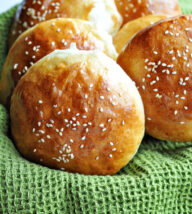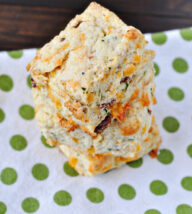Homemade Brioche Loaf Bread
This homemade brioche loaf bread is rich and buttery but is made with less eggs and butter. This makes it perfect as an everyday sandwich loaf.
Homemade bread ranks pretty high on my list of things I’m so glad I can make at home (with ice cream taking the number one spot). It may seem silly to make your own sandwich bread, given that it’s readily available and because homemade bread seems like such a hassle. Let me tell you – it is totally worth the time it takes, and most of that time is spent waiting on the dough to rise anyway.
This bread is a less rich version of brioche. I’ve posted a brioche recipe before, and that one is fantastic as dinner rolls. However, I wanted something with less butter to use as an everyday sandwich bread. Enter this bread, known as “Poor Man’s Brioche” because it uses less eggs and butter than traditional brioche.
I originally made this homemade brioche loaf bread with the intent of using it for sandwiches, but I’ll be honest and tell you that most of it got eaten slice by slice, straight off the loaf. Even though it doesn’t have nearly as much butter as its traditional counterpart, this brioche is still rich and tender, making it basically irresistible. The Cobb salad sandwiches we made with it were some of the best I’ve had, and it also makes killer French toast.
- COOK TIME:
- YIELD: 2 loaves
For the sponge:
½ cup (2.25 ounces) unbleached bread flour
2 teaspoons (.22 ounce) instant yeast
½ cup (4 ounces) whole milk, lukewarm
For the dough:
4 large (6.6 ounces) eggs, lightly beaten
3¼ cups (14.75 ounces) unbleached bread flour
2 tablespoons (1 ounce) granulated sugar
1¼ teaspoons (.31 ounce) kosher salt
½ cup (4 ounces) unsalted butter, at room temperature
1 egg, whisked until frothy (for egg wash)
- 1
To make the sponge, stir together the flour in yeast in the bowl of an electric mixer. Add the milk, and stir until all the flour is moistened. Cover with plastic wrap and allow to ferment for 30-45 minutes, or until the sponge rises and then falls when you tap the bowl.
- 2
To make the dough, add the eggs to the sponge and beat on medium speed with the paddle attachment until smooth. In a separate bowl, whisk together the flour, sugar and salt. With the mixer on low speed, add in the flour and mix until evenly combined. Allow to rest for 5 minutes.
- 3
Replace the paddle with the dough hook and, with the mixer on medium speed, add the butter one tablespoon at a time, waiting until it’s incorporated before adding more. Reduce speed to low and continue kneading with the dough hook for 6-8 minutes, or until the dough is well mixed and easily clears the sides and bottom of the bowl, adding small amounts of flour as needed. The dough should be smooth and soft but not sticky.
- 4
Lightly oil a bowl and transfer the dough to it. Lightly mist the top of the dough with spray oil and cover with plastic wrap. Allow to ferment for about 90 minutes, or until the dough doubles in size.
- 5
Grease two 8.5 x 4.5-inch loaf pans. Divide the dough in half. Working with one half at a time, flatten the dough with your hands to form a rectangle about 5 inches wide and 6-8 inches long. Working from the short side, roll up the length of the dough one section at a time, pinching the crease after each turn. The loaf will spread as you roll it, and the final length should be 8-9 inches, depending on the size loaf pan you have. Pinch the final seam closed, then roll the loaf back and forth to even it out, taking care not to taper the edges. (See this post for step by step photos of the shaping process.) Repeat with remaining dough.
- 6
Place the loaves in the prepared pans, making sure that the ends of the loaves touch the ends of the pans. Mist the top of the loaves with spray oil and loosely cover with plastic wrap. Proof the dough for 60-90 minutes, or until it nearly fills the pans. Gently brush the tops with egg wash. Cover again with plastic wrap that has been lightly misted with spray oil. Continue proofing for 15-30 minutes, until the dough fills the pans.
- 7
Heat oven to 350º and bake for 35-50 minutes. The finished loaf should be 190ºF in the center, and the bottom should sound hollow when thumped. Remove the loaves from the pans as soon as you take them out of the oven. Cool on a rack for at least 1 hour before cutting and serving (though really, who has the willpower to do that?).
To store, wrap the cooled loaf in plastic wrap or store in a plastic bag in a cool, dark place. Do not refrigerate it because doing so will cause the bread to dry out. If it cannot be eaten within 3 days, I recommend slicing then freezing it, which allows you to remove only as many slices as you need at a time.






Homemade bread is the best!! Especially Brioche!
Homemade bread is the best!! Especially Brioche!
I’m so so glad you posted pictures because you gave me confidence to try to make brioche bread and it’s all I’ve been eating all day! I love the idea of using it in place of sandwich bread; my regular sandwich loaf recipe has been hit or miss, so I think I want to try this one because it’s easier than the one I used!
I’m so so glad you posted pictures because you gave me confidence to try to make brioche bread and it’s all I’ve been eating all day! I love the idea of using it in place of sandwich bread; my regular sandwich loaf recipe has been hit or miss, so I think I want to try this one because it’s easier than the one I used!
Gorgeous, Courtney! This sounds like a great project to do with Caroline and Smith since they’re on spring break this week!
Ooh, I bet they would love that! I’m going to go ahead and request pictures of this, please. 🙂
Gorgeous, Courtney! This sounds like a great project to do with Caroline and Smith since they’re on spring break this week!
Ooh, I bet they would love that! I’m going to go ahead and request pictures of this, please. 🙂
I can never control myself around homemade bread…especially not rich breads like this! I see this loaf disappearing pretty quickly around here…slice by slice. It’s so gorgeous!
I can never control myself around homemade bread…especially not rich breads like this! I see this loaf disappearing pretty quickly around here…slice by slice. It’s so gorgeous!
I am with Joanne—-If I got anywhere near that loaf especially hot out of the oven and extra especially if I had butter, it would be gone baby gone. Your loaf is picture perfect. The even texture is something to be quite proud of. Good job!
I am with Joanne—-If I got anywhere near that loaf especially hot out of the oven and extra especially if I had butter, it would be gone baby gone. Your loaf is picture perfect. The even texture is something to be quite proud of. Good job!
I made the bread today but unfortunately I found it too salty. I think if i was to make it again I would leave the salt out of the recipe.
Sorry to hear that! We’ve made it several times and never found it too salty. Salt adds flavor, so I’d recommend reducing it instead of completely eliminating it if you make it again.
I will try again but because the bread flour I use has salt already in it and the recipe says add I 1/4teaspoons do you think this could contribute to the salty taste. And I also think that maybe US measurements are slightly smaller to NZ measurements, so I may have to do a few adjustments.
Oh yeah, that could definitely be it. I also almost always use kosher salt, which is a more coarse than regular salt. I hope it turns out well next time!